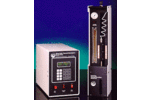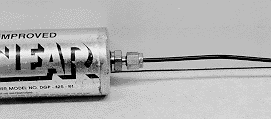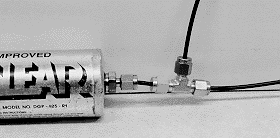- ▶
- Heaters/Source
- ▶
- Agilent Heaters and SensorsMass Spectrometry, Scientific Supplies & ManufacturingScientific Instrument Services 5973 Source Heater Tamper Resistant Allen Wrench 5973/5975 Quad Sensor 5985 Source Heater Assembly Agilent Interface Heater Assembly 5971 Interface Heater

- ▶
- Reference Material on InstrumentationArticle - A High Temperature Direct Probe for a Mass Spectrometer Design of a Direct Exposure Probe and Controller for use ona Hewlett-Packard 5989 Mass Spectrometer SIS AP1000 AutoProbe™ SIS AP2000 AutoProbe™ - Description of System HPP7: Direct Probe Electronics Console HPP7: Direct Probe for the Agilent (HP) 5973/5975 MSD HPP7: HP Direct Probe Application Notes HPP7: Installation Directions for the Direct Probe HPP7: Side Cover for the HP 5973 MSD HPP7: Support HPP7: Probe Inlet System for the Agilent (HP) 5973 and 5975 MSD with Automatic Indexed Stops HPP7: Theory of Operation of the Direct Probe and Probe Inlet System Direct Thermal Extraction Thermal Desorption Application Notes Environmental Thermal Desorption Application Notes Food Science Thermal Desorption Application Notes Forensic Thermal Desorption Application Notes GC Cryo-Trap Application Notes Headspace Application Notes Purge & Trap Thermal Desorption Application Notes Theory of Operation of the AutoDesorb® System AutoDesorb Notes for SIS Dealers Adsorbent Resin Application Notes Installation of the Short Path Thermal Desorption System on Agilent (HP) and Other GCs Installation of the Short Path Thermal Desorption System on a Varian 3400 GC AutoDesorb® System Development Team Thermal Desorption Applications and Reference Materials Installation of the Short Path Thermal Desorption System - TD5 Part I - Design & Operation of the Short Path ThermalDesorption System Installation Instructions for the Model 951 GC Cryo-Trap on the HP 5890 Series GC Installation Instructions for the Model 961 GC Cryo-Trap on the HP 5890 Series GC Operation of the Model 951/961 GC Cryo-Trap SIS GC Cryo Traps - Theory of Operation NIST/EPA/NIH Mass Spectral Enhancements - 1998 version (NIST98) SIMION 3D Ion Optics Class Mass Spectrometer Source Cleaning Methods MS Tip: Mass Spectrometer Source Cleaning Procedures Mass Spec Source Cleaning Procedures Micro-Mesh® Abrasive Sheets Research Papers Using New Era Syringe Pump Systems EI Positive Ion Spectra for Perfluorokerosene (PFK) Cap Liner Information How do I convert between fluid oz and milliliters? Which bottle material should I choose? Which bottle mouth should I choose? The Bottle Selection Guide CGA Connections for Gas Tanks Chemical Reaction Interface Mass Spectrometry (CRIMS)

- TD
- LiteratureApplication Notes Adsorbent Resins Guide Mass Spec Tips SDS Sheets FAQ MS Calibration Compound Spectra Manuals MS Links/Labs/ Organizations MS Online Tools Flyers on Products/Services Scientific Supplies Catalog About Us NextAdvance Bullet Blender® Homogenizer Protocols Micro-Mesh® Literature Instrumentation Literature Agilent GC/MS Literature SIS News / E-Mail Newsletter NIST MS Database - Update Notifications

- ▶
- Installation of the Short Path Thermal Desorption System - TD5 (This Page)
 Varian 3400 The entire S.P.T.D. system can be installed by the end user. However, Scientific Instrument Services also provides installation by S.I.S. qualified staff.
Varian 3400 The entire S.P.T.D. system can be installed by the end user. However, Scientific Instrument Services also provides installation by S.I.S. qualified staff. Agilent and Others Site Preparation Installation of the SPTD on Varian 3400 HP 5890 and Other GCs Careful adherence to these installation instructions should allow the user to install the SPTD system on the HP 5890 and other gas chromatographs. Be certain that you read through the instructions completely and acquire all the tools required before proceeding. The section on site preparation found in this manual should also be read through completely to be sure that you are ready for installation. For further help i...
Agilent and Others Site Preparation Installation of the SPTD on Varian 3400 HP 5890 and Other GCs Careful adherence to these installation instructions should allow the user to install the SPTD system on the HP 5890 and other gas chromatographs. Be certain that you read through the instructions completely and acquire all the tools required before proceeding. The section on site preparation found in this manual should also be read through completely to be sure that you are ready for installation. For further help i...
SITE PREPARATION
Space Requirements
The Short Path Thermal Desorption System is a compact, self contained injection system and desorption system that requires a minimum amount of space. The system is designed only for top injecting GC systems. The Thermal Desorption Unit sits directly over the injection port of the Gas Chromatograph. The base of the Thermal Desorption Unit is only 5.5 inches wide x 6.5 inches deep and the overall height is 22 inches.
The Electronics Control System is 7 inches wide x 14.5 inches deep x 11 inches high, and normally can sit on top of the GC oven cabinet providing it does not interfere with the operation of the GC. Alternatively, the Electronics console can be placed on the lab bench next to the GC or on any other suitable shelf or supporting medium within 4 feet of the GC injection port.

Fig.2.1 S.P.T.D. mounted on Varian 3400 GC
Line Voltage & Current
The Short Path Thermal Desorption System requires a single 115 volt, 10 amp, 60 Hz, grounded outlet. The system is fuse protected with a main power fuse and a second fuse for the cartridge heater circuit. In no case should a fuse larger than the size recommended in this manual be used.
Power requirements are 115 Volts +/- 10% AC and 10 amp max.
Gas Considerations
Desorbing Gas
Standard GC carrier gas is utilized as the desorbing gas for the Short Path Thermal Desorption System. High purity gases such as Nitrogen or Helium are recommended. The carrier gas should have a purity of at least 99.995% and must be delivered at 40-60 psi and 100cc/min maximum (0.04CFM).
The same carrier gas used for the capillary or packed column carrier gas should be used as the desorbing gas in the Short Path Thermal Desorption System to avoid mixing gases in the GC injection port; which could cause an unstable baseline, especially with FID detectors. Due to the high temperatures and rapid heating of the components in the desorption system, the use of hydrogen could create an explosive condition
CAUTION - DO NOT USE HYDROGEN GAS IN THE DESORPTION SYSTEM
NOTE: The carrier gas for the desorption system can easily be plumbed in by adding a cross or tee into the carrier gas line before it enters the gas chromatograph. The instructions below describe how to do this.
1. The installation of a cross or tee in the carrier gas line requires a tubing cutter, a 7/16 inch wrench and a Swagelok brass cross (B-200-4) or brass tee (B-200-3).
2. Turn off the carrier gas at its source.
Installation of Cross in Varian 3400 GC Carrier Gas Line
1. Figure 2.2 shows the standard gas hookup on a Varian 3400 GC.
2. Remove the 1/8 inch Swagelok tee and replace it with a 1/8 inch Swagelok cross. See Figure 2.3.
3. Use the top fitting to hookup the carrier gas line to the SPTD unit.
4. Be sure the tubing is completely seated in the fitting and tighten 3/4 turns past finger tight.

Fig. 2.2 Standard carrier gas hookup on Varian 3400 GC.

Fig. 2.3 Cross installed allowing carrier gas hookup to S.P.T.D.
Installation of tee in Agilent 5890 GC Carrier Gas Line
1. Figure 2.4 shows the standard carrier gas hookup on the Agilent 5890 GC.
2. Using the tubing cutter cut the 1/8 inch tubing about 2 inches from the back of the GC.
3. Check that the ends of the tubing that you just cut are clean, open and burr free.
4. Install the tee as shown in Figure 2.5. Be sure the tubing is completely seated in the Swagelok fitting and tighten finger tight. Tighten 3/4 turns further with the small wrench.
5. Use the side arm of the tee to hookup the carrier gas line to the SPTD unit.

Fig. 2.4 Standard gas hookup for Agilent 5890 GC.

Fig. 2.5 Tee installed allowing carrier gas hookup to S.P.T.D.
Compressed Air for Solenoids
A supply of clean compressed air or nitrogen is required. Compressed Air from Laboratory supply or cylinder at 40 psi, 100 cc/min maximum (0.04 cfm) is required. The fitting required for installation of the S.P.T.D. system is a 1/8 inch Swagelok fitting.
Cryo-Cooling
Cryo cooling capabilities using liquid Nitrogen or Carbon Dioxide are recommended for the GC oven or alternatively using the GC Cryo-Trap accessory. Normally samples are desorbed from the desorption tube and trapped on the front of the GC column. In some cases these volatiles can be trapped on thick film megabore columns such as the SGE BPX-624 column. However for microbore capillary columns and thin film columns it is preferable to cool the column below 0 degrees C in order to trap the volatiles. Cryo cooling is available on most gas chromatographs. Usually this accessory is ordered when the GC is first purchased, however most gas chromatographs can be upgraded to include cryo-cooling. For example, the Agilent 5890, 6890 or 7890 GC can be easily retrofitted with cryo cooling. The kit (available from SIS) costs less than $500.00 and requires about 20 minutes to install.
However for optimum results and minimum use of cooling gas, use the GC Cryo-Trap which can be purchased as an accessory for the SPTD System. The GC Cryo-Trap can be controlled via the SPTD electronics to regulate both cooling and heating temperatures as well as the switching between the two states.
Installation
Instructions follow for installation of the Short Path Thermal Desorption System (S.P.T.D.) on various gas chromatographs. The following sections are included:
Installation of the S.P.T.D. System on the Varian 3400
Installation of the S.P.T.D. System on the Agilent 5890
Installation of the S.P.T.D. System on other GC's
Careful adherence to these installation instructions should allow the user to install the S.P.T.D. system on either the Varian 3400 or Agilent 5890 gas chromatographs. Be certain that you read through the instructions completely and acquire all the tools required before proceeding. The section on site preparation found in this manual should also be read through completely to be sure that you are ready for installation.
For further help in installation call
S.I.S. customer support at
contact us.
The entire S.P.T.D. system can be installed by the end user. However, Scientific Instrument Services also provides installation by S.I.S. qualified staff. This includes installation of the Short Path Thermal Desorption on your GC or GC/MS system and training to get you up and running with your new system. Price includes all travel and lodging and expenses for 1.5 days at your location. Please call S.I.S. for more details.

